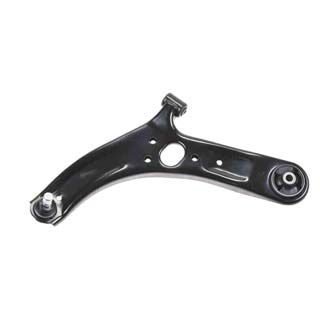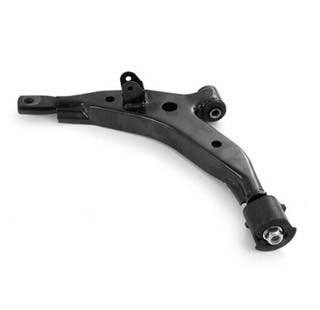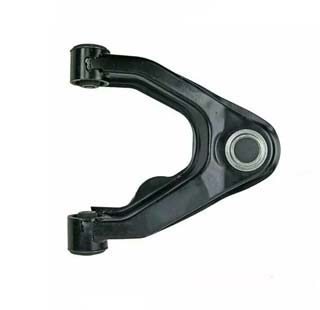Car suspension is a complex system that plays a pivotal role in ensuring a smooth and controlled ride. Among its many components, the lower arms stand out as critical elements, providing the foundation for the suspension system. In this exploration, we delve into the intricate world of car suspension control arm, focusing on the specific importance of Cruze lower arms.
The Anatomy of Cruze Lower Arms: A Structural Marvel
Cruze lower arms, also known as control arms or A-arms, are fundamental components of a vehicle's suspension system. These arms connect the suspension to the frame of the car, acting as crucial links that allow for controlled movement. Constructed from durable materials such as steel or aluminum, Cruze lower arms are engineered to withstand the dynamic forces encountered during vehicle operation.
These arms typically come in pairs, with one on each side of the vehicle's front or rear suspension. Their design involves a pivoting connection at both ends, allowing for the necessary articulation as the car navigates uneven terrain. The structural marvel of Cruze lower arms lies in their ability to maintain proper wheel alignment, absorb road shocks, and contribute to overall stability.
Dynamic Functionality: How Cruze Lower Arms Enhance Suspension Performance
The functionality of Cruze lower arms goes beyond mere structural support. These components actively contribute to the dynamic performance of a vehicle's suspension system. As the car encounters bumps, potholes, or varying road surfaces, the lower arms play a crucial role in distributing forces and minimizing vibrations. This dynamic functionality ensures a comfortable and controlled driving experience for passengers.
Additionally, this cruze lower arm is integral to maintaining wheel alignment, preventing uneven tire wear. Proper alignment not only enhances safety but also improves fuel efficiency by reducing rolling resistance. The geometry of the lower arms is carefully engineered to optimize wheel movement, providing the necessary balance between comfort and handling precision.
Challenges and Innovations: Advancements in Cruze Lower Arm Technology
While Cruze lower arms have been integral to automotive design for decades, continuous advancements in technology bring about new challenges and opportunities. Manufacturers are constantly innovating to improve the strength, durability, and weight of these components. The use of advanced materials, such as high-strength alloys and composite materials, has become more prevalent, contributing to lighter yet robust lower arm designs.
Innovations also extend to the integration of smart suspension systems that adapt to real-time driving conditions. Some modern vehicles equipped with electronic suspension controls leverage data from sensors to adjust the characteristics of the lower arms, optimizing ride comfort and handling performance.
In conclusion, Cruze lower arms serve as the backbone of a vehicle's suspension system, providing structural support and dynamic functionality. Understanding their anatomy, functionality, and the ongoing innovations in their design sheds light on their crucial role in ensuring a smooth and controlled driving experience. As automotive technology continues to evolve, the exploration of Cruze lower arms remains integral to enhancing the overall performance and safety of modern vehicles.
Related SAFE Control Arms & Parts
Related News Of SAFE Control Arms & Parts
-
Control Arm
-
Honda Control Arm
- Honda Accord 1999-2003 Upper Arm
- Honda Accord 2003-2007 Upper Arm
- Honda Accord 2008-2015 Upper Arm
- Honda Accord 2009-2014 Control Arm
- Honda Civic 1995-2001 Control Arm
- Honda Civic 1996-2000 Upper Arm
- Honda Civic 2001-2005 Control Arm
- Honda Civic 2006-2011 Control Arm
- Honda Civic 2012 AT Control Arm
- Honda Civic 2012-2016 Control Arm
- Honda CR-V 1997-2001 Upper Arm
- Honda CR-V 1997-2001 Control Arm
- Honda CR-V 2002-2006 Control Arm
- Honda Fit 2015-2020 Control Arm
- Honda JAZZ 2002-2008 Control Arm
- Honda JAZZ 2008-2020 Control Arm
-
Toyota Control Arm
- Toyota Avanza 2003-2011 Control Arm
- Toyota Avensis 2001-2009 Control Arm
- Toyota Aygo 2005-2014 Control Arm
- Toyota Camry 1992-1997 Control Arm
- Toyota Camry 1997-2001 Control Arm
- Toyota Camry 2007-2011 Control Arm
- Toyota Camry 2018-2021 Control Arm
- Toyota C-HR 2018-2021 Control Arm
- Toyota Corolla Control Arm 2003-2008
- Toyota Corolla Control Arm 2006-2018
- Toyota Corolla Control Arm 2014-2019
- Toyota Corolla Control Arm 2019-2022
- Toyota Echo Control Arm 2004-2005
- Toyota Hiace Control Arm 2006-2022
- Toyota Hiace Control Arm Up 1989-2001
- Toyota Hiace Control Arm Up 1989-2004
- Toyota Hiace Control Arm Up 2004-2021
- Toyota Highlander Control Arm 2008-2013
- Toyota Hilux Control Arm 1983-1988
- Toyota Hilux Control Arm 1988-1999
- Toyota Hilux Control Arm 2005-2015
- Toyota Hilux Control Arm 4WD 2005-2015
- Toyota Hilux Control Arm 4WD 2015-2021
- Toyota Hilux Control Arm Up 1988-2004
- Toyota Hilux Control Arm Up 2005-2021
- Toyota Hilux Control Arm Up 4WD 2005-2021
- Toyota Land Cruiser 5.7 Control Arm Up 2008-2019
- Toyota Land Cruiser Control Arm 2002-2010
- Toyota Land Cruiser Control Arm 2010-2021
- Toyota Land Cruiser Control Arm Up 1998-2007
- Toyota Land Cruiser Control Arm Up 2016-2020
- Toyota Rav4 2006-2018 Control Arm
- Toyota Rav4 2019-2022 Control Arm
- Toyota Reiz 2005-2010 Control Arm
- Toyota Sienna 2004-2010 Control Arm
- Toyota Sienna 2011-2019 Control Arm
- Toyota Vitz Control Arm 1999-2005
- Toyota Yaris Control Arm 1999-2005
- Toyota Yaris Control Arm 2006-2014
- Toyota Yaris Control Arm 2014-2022
-
Mazda Control Arm
- Mazda 2 2003-2007 Control Arm
- Mazda 2 2007-2015 Lower Control Arm
- Mazda 3 2010-2013 Control Arm
- Mazda 3 2014-2018 Control Arm
- Mazda 323 1998-2004 Control Arm
- Mazda 5 2005-2010 Control Arm
- Mazda 6 2007-2013 Lower Control Arm
- Mazda 6 2007-2017 Upper Control Arm
- Mazda 6 Bent 2003-2007 Lower Control Arm
- Mazda 6 Straight 2003-2007 Lower Control Arm
- Mazda 6 Upper 2003-2007 Control Arm
- Mazda 626 1988-1997 Control Arm
- Mazda 626 1997-2002 Control Arm
- Mazda CX-5 2014-2017 Control Arm
- Mazda Tribute 2000-2008 Control Arm
-
Nissan Control Arm
- Nissan Altima 2002-2006 Control Arm
- Nissan Altima 2007-2013 Control Arm
- Nissan Frontier D22 2wd 1998-2004 Upper Arm
- Nissan Juke 2010-2022 Control Arm
- Nissan Kicks 2018-2021 Control Arm
- Nissan March K13 2013-2021 Control Arm
- Nissan Maxima 1996-1999 Control Arm
- Nissan Maxima 2009-2013 Control Arm
- Nissan Murano 2003-2008 Control Arm
- Nissan Navara D40 2006-2014 Upper Arm
- Nissan Navara D40 2006-2020 Control Arm
- Nissan NV200 2010-2020 Control Arm
- Nissan Pathfinder 1996-2004 Control Arm
- Nissan Pathfinder 2013-2019 Control Arm
- Nissan Pickup D22 2WD 1998-2004 Control Arm
- Nissan Pickup D22 4WD 1998-2004 Control Arm
- Nissan Pickup D22 4WD 1998-2004 Upper Arm
- Nissan Qashqai 2008-2015 Control Arm
- Nissan Qashqai 2013-2022 Control Arm
- Nissan Sentra 2001-2006 Control Arm
- Nissan Sentra 2007-2012 Control Arm
- Nissan Sunny B12 1986-1990 Control Arm
- Nissan Sunny B13 1990-1995 Control Arm
- Nissan Sunny B14 1995-2000 Control Arm
- Nissan Tiida C12 2011-2016 Control Arm
- Nissan Urvan 2002-2007 Upper Arm
- Nissan Urvan 2002-2013 Control Arm
- Nissan Urvan 2012-2017 Control Arm
- Nissan X-trail 2001-2013 Control Arm
- Nissan X-trail 2014-2022 Control Arm
- SUZUKI Control Arm
-
Hyundai KIA Control Arm
- Hyundai Accent 1994-2000 Control Arm
- Hyundai Accent 2000-2006 Control Arm
- Hyundai Accent 2012-2017 Control Arm
- Hyundai Atos 1997-2017 Control Arm
- Hyundai Cerato 2004-2009 Control Arm
- Hyundai Elantra 2000-2006 Control Arm
- Hyundai Elantra 2007-2010 Control Arm
- Hyundai Elantra 2012-2016 Control Arm
- Hyundai Getz 2002-2010 Control Arm
- Hyundai H100 1993-2000 Upper Arm
- Hyundai I10 2013-2021 Control Arm
- Hyundai I20 2008-2015 Control Arm
- Hyundai I30 2012-2022 Control Arm
- Hyundai Ix35 2009-2015 Control Arm
- Hyundai Santa 2001-2006 Control Arm
- Hyundai Santa 2006-2012 Control Arm
- Hyundai Santa 2013-2022 Control Arm
- Hyundai Sonata 1998-2001 Control Arm
- Hyundai Sonata 1999-2006 Upper Control Arm Rear
- Hyundai Sonata 1999-2006 Upper Arm
- Hyundai Sonata 2006-2010 Control Arm
- Hyundai Sonata 2007-2011 Upper Arm
- Hyundai Sonata 2015-2019 Control Arm
- Hyundai Tucson 2004-2010 Control Arm
- Kia Carens 2006-2018 Control Arm
- Kia Forte 2010-2013 Control Arm
- Kia Forte 2014-2018 Control Arm
- Kia Picanto 2004-2008 Control Arm
- Kia Picanto 2008-2011 Control Arm
- Kia Picanto 2011-2017 Control Arm
- Kia Rio 2006-2011 Control Arm
- Kia Rio 2012-2017 Control Arm
- Kia Soul 2010-2013 Control Arm
-
MITSUBISHI Control Arm
- Mitsubishi Grandis 2003-2011 Control Arm
- Mitsubishi L200 2005-2015 4WD Upper Control Arm
- Mitsubishi L200 2005-2015 Upper Control Arm
- Mitsubishi L300 1986-2004 Control Arm
- Mitsubishi Lancer 2002-2006 Control Arm
- Mitsubishi Mirage 1997-2002 Control Arm
- Mitsubishi Mirage Rear 1993-2002
- Mitsubishi Outlander 2002-2005 Control Arm
- Mitsubishi Outlander 2007-2012 Control Arm
- Mitsubishi Pajero 2000-2022 Upper Control Arm
-
Chevrolet Control Arm
- Chevrolet Aveo 2004-2011 Control Arm
- Chevrolet Cruze 2011-2015 Control Arm
- Chevrolet Cruze 2016-2019 Control Arm
- Chevrolet Epica 2004-2006 Control Arm
- Chevrolet Equinox 2018-2022 Control Arm
- Chevrolet Impala 2006-2013 Control Arm
- Chevrolet Malibu 2004-2012 Control Arm
- Chevrolet Malibu 2016-2021 Control Arm
- Chevrolet Matiz 2005-2017 Control Arm
- Chevrolet Sonic 2012-2017 Control Arm
- Chevrolet Sprak 2013-2015 Control Arm
- Chevrolet Sprak 2016-2022 Control Arm
- Chevrolet Traverse 2009-2017 Control Arm
- Chevrolet Trax 2013-2022 Control Arm
- Chevrolet Uplander 2005-2009 Control Arm
- Opel Control Arm
-
Honda Control Arm
- Control Arm Bushing
- Ball Joint




